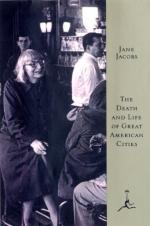|
This section contains 344 words (approx. 1 page at 400 words per page) |

|
Part 3, Chapter 14, The Curse of Border Vacuums Summary and Analysis
Single use areas form borders in cities, like railroad tracks do. There is usually blight in areas adjacent to the tracks just as there sometimes is in areas along the waterfront. Neighborhoods around universities, hospitals, and civic centers are usually stagnant instead of vibrant. City land falls into one of two categories, according to Jacobs. The first is general land. People who walk around and circulate use it. In this category are streets, parks, and some building lobbies. Special land is the second kind of land and usually isn't used by the walking population. It functions as an obstacle to the use of general land because it blocks general land. Both serve to contribute to circulation. When special land interferes with the use of general lands in downtown areas...
(read more from the Part 3, Chapter 14, The Curse of Border Vacuums Summary)
|
This section contains 344 words (approx. 1 page at 400 words per page) |

|




